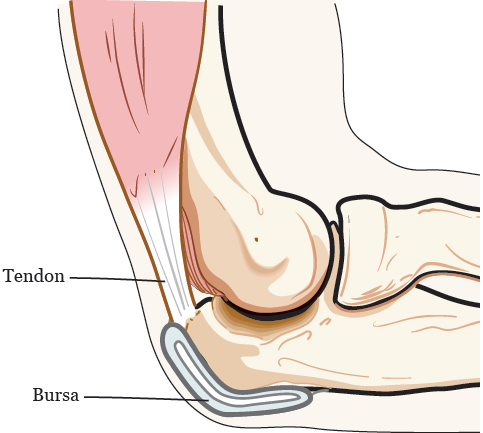This information will help you understand bursitis, including causes, diagnosis, and treatment.
About Your Bursae
Your bursae are small pads filled with fluid that act as cushions between your bones, tendons, and the muscles near your joints (see Figure 1). There are over 150 bursae in your body.

When a bursa swells, you get a painful condition called bursitis. Bursitis usually happens in the shoulder, elbow, hip, and knee.
Causes of Bursitis
There are many causes of bursitis, including:
- Wearing tight-fitting shoes
- Kneeling, sitting, or lying on your side for long periods
- Stressing or overusing a joint by bicycling, running, playing tennis, throwing a ball many times, or carrying heavy objects
- Injuries, especially falls
- Aging
- Poor posture
- Irritation of a bursa from:
- Joint surgery or surgically implanted hardware, such as a hip replacement
- Bony growths on the edges of your bones (bone spurs) or calcium deposits on your tendons
- Other medical conditions including gout, diabetes, rheumatoid arthritis, and thyroid disease
Symptoms of Bursitis
Common symptoms of bursitis include:
- Pain, stiffness, swelling, or discomfort around your elbow, hip, knee, shoulder, or other joints. You may feel this while you’re moving or at rest.
- Loss of movement due to pain and swelling.
Diagnosis of Bursitis
Your healthcare provider can usually tell if you have bursitis based on your symptoms and a physical exam. They may give you a blood test and x-rays to rule out other possible problems. If there are signs of infection, you may need to have an aspiration. An aspiration is a procedure that removes a small amount of bursa fluid with a needle.
Treatment for Bursitis
Your treatment may include rest, medications, icing your joint, occupational or physical therapy, steroid injections, or draining the fluid (aspiration). Your healthcare team will make treatment recommendations based on your symptoms.
The goal of treatment is to:
- Reduce pain and inflammation.
- Maintain the use of your joint.
- Help prevent bursitis from coming back.
Rest
Rest your joints and avoid activities that cause pain and worsen your symptoms.
Medications
Your healthcare provider may recommend that you take nonsteroidal anti-inflammatory drugs (NSAIDs). Some of these you can buy over-the-counter (medications you buy without a prescription). Some examples of NSAIDs include:
- Ibuprofen (Advil®, Motrin®)
- Celecoxib (Celebrex®)
- Naproxen (Aleve®, Naprosyn®)
- Diclofenac (Voltaren®)
- Mobic (Meloxicam®)
NSAIDs may have side effects. Talk with your healthcare provider before taking NSAIDs.
Ice
Your healthcare provider may tell you to ice your joints. Apply ice for no longer than 15 minutes every 4 to 6 hours.
Rehabilitation therapy
Your healthcare provider may refer you to an occupational or physical therapist. Your therapist will:
- Show you exercises that will strengthen your joints.
- Tell you how to protect your joints, which helps healing and prevents bursitis from coming back.
- Provide an ultrasound, massage, or other therapies.
Steroid injections and fluid draining
If your symptoms continue or get worse, your healthcare provider may inject a steroid into the area surrounding your joint. This will help to decrease swelling and pain. For more information about steroid injections, read our resource Steroid Injections (www.mskcc.org/pe/steroid_injections).
If you have bursa fluid, your healthcare provider may also drain the fluid in your joint using a needle. This will help to relieve pain.